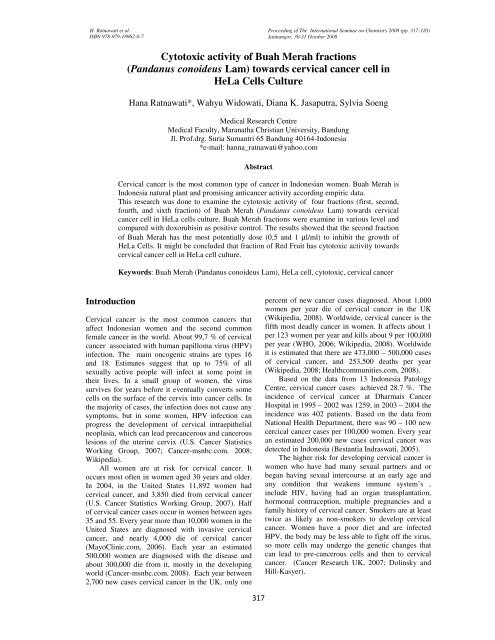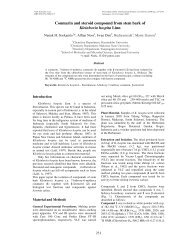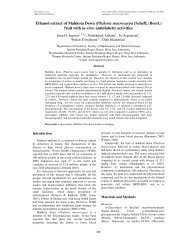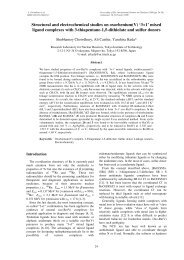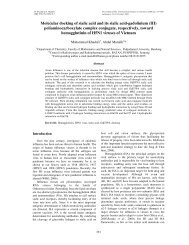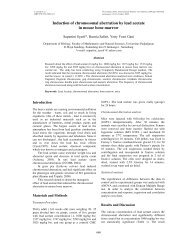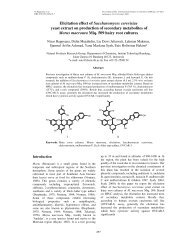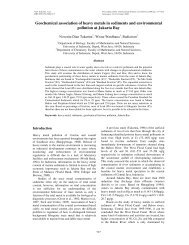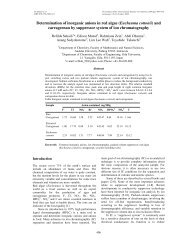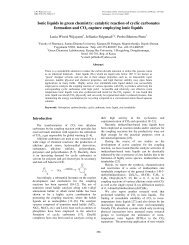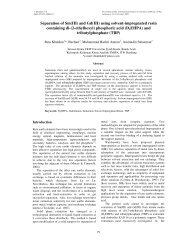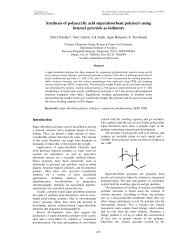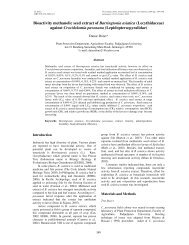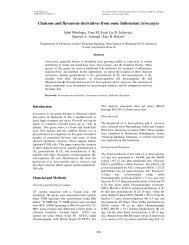Cytotoxic activity of Buah Merah fractions (Pandanus conoideus ...
Cytotoxic activity of Buah Merah fractions (Pandanus conoideus ...
Cytotoxic activity of Buah Merah fractions (Pandanus conoideus ...
Create successful ePaper yourself
Turn your PDF publications into a flip-book with our unique Google optimized e-Paper software.
H. Ratnawati et al. Proceeding <strong>of</strong> The International Seminar on Chemistry 2008 (pp. 317-320)<br />
ISBN 978-979-18962-0-7<br />
Jatinangor, 30-31 October 2008<br />
<strong>Cytotoxic</strong> <strong>activity</strong> <strong>of</strong> <strong>Buah</strong> <strong>Merah</strong> <strong>fractions</strong><br />
(<strong>Pandanus</strong> <strong>conoideus</strong> Lam) towards cervical cancer cell in<br />
HeLa Cells Culture<br />
Hana Ratnawati*, Wahyu Widowati, Diana K. Jasaputra, Sylvia Soeng<br />
Medical Research Centre<br />
Medical Faculty, Maranatha Christian University, Bandung<br />
Jl. Pr<strong>of</strong>.drg. Suria Sumantri 65 Bandung 40164-Indonesia<br />
*e-mail: hanna_ratnawati@yahoo.com<br />
Abstract<br />
Cervical cancer is the most common type <strong>of</strong> cancer in Indonesian women. <strong>Buah</strong> <strong>Merah</strong> is<br />
Indonesia natural plant and promising anticancer <strong>activity</strong> according empiric data.<br />
This research was done to examine the cytotoxic <strong>activity</strong> <strong>of</strong> four <strong>fractions</strong> (first, second,<br />
fourth, and sixth fraction) <strong>of</strong> <strong>Buah</strong> <strong>Merah</strong> (<strong>Pandanus</strong> <strong>conoideus</strong> Lam) towards cervical<br />
cancer cell in HeLa cells culture. <strong>Buah</strong> <strong>Merah</strong> <strong>fractions</strong> were examine in various level and<br />
compared with doxorubisin as positive control. The results showed that the second fraction<br />
<strong>of</strong> <strong>Buah</strong> <strong>Merah</strong> has the most potentially dose (0,5 and 1 µl/ml) to inhibit the growth <strong>of</strong><br />
HeLa Cells. It might be concluded that fraction <strong>of</strong> Red Fruit has cytotoxic <strong>activity</strong> towards<br />
cervical cancer cell in HeLa cell culture.<br />
Keywords: <strong>Buah</strong> <strong>Merah</strong> (<strong>Pandanus</strong> <strong>conoideus</strong> Lam), HeLa cell, cytotoxic, cervical cancer<br />
Introduction<br />
Cervical cancer is the most common cancers that<br />
affect Indonesian women and the second common<br />
female cancer in the world. About 99,7 % <strong>of</strong> cervical<br />
cancer associated with human papilloma virus (HPV)<br />
infection. The main oncogenic strains are types 16<br />
and 18. Estimates suggest that up to 75% <strong>of</strong> all<br />
sexually active people will infect at some point in<br />
their lives. In a small group <strong>of</strong> women, the virus<br />
survives for years before it eventually converts some<br />
cells on the surface <strong>of</strong> the cervix into cancer cells. In<br />
the majority <strong>of</strong> cases, the infection does not cause any<br />
symptoms, but in some women, HPV infection can<br />
progress the development <strong>of</strong> cervical intraepithelial<br />
neoplasia, which can lead precancerous and cancerous<br />
lesions <strong>of</strong> the uterine cervix (U.S. Cancer Statistics<br />
Working Group, 2007; Cancer-msnbc.com. 2008;<br />
Wikipedia).<br />
All women are at risk for cervical cancer. It<br />
occurs most <strong>of</strong>ten in women aged 30 years and older.<br />
In 2004, in the United States 11,892 women had<br />
cervical cancer, and 3,850 died from cervical cancer<br />
(U.S. Cancer Statistics Working Group, 2007). Half<br />
<strong>of</strong> cervical cancer cases occur in women between ages<br />
35 and 55. Every year more than 10,000 women in the<br />
United States are diagnosed with invasive cervical<br />
cancer, and nearly 4,000 die <strong>of</strong> cervical cancer<br />
(MayoClinic.com, 2006). Each year an estimated<br />
500,000 women are diagnosed with the disease and<br />
about 300,000 die from it, mostly in the developing<br />
world (Cancer-msnbc.com. 2008). Each year between<br />
2,700 new cases cervical cancer in the UK, only one<br />
percent <strong>of</strong> new cancer cases diagnosed. About 1,000<br />
women per year die <strong>of</strong> cervical cancer in the UK<br />
(Wikipedia, 2008). Worldwide, cervical cancer is the<br />
fifth most deadly cancer in women. It affects about 1<br />
per 123 women per year and kills about 9 per 100,000<br />
per year (WHO, 2006; Wikipedia, 2008). Worldwide<br />
it is estimated that there are 473,000 – 500,000 cases<br />
<strong>of</strong> cervical cancer, and 253,500 deaths per year<br />
(Wikipedia, 2008; Healthcommunities.com, 2008).<br />
Based on the data from 13 Indonesia Patology<br />
Centre, cervical cancer cases achieved 28.7 %. The<br />
incidence <strong>of</strong> cervical cancer at Dharmais Cancer<br />
Hospital in 1995 – 2002 was 1259, in 2003 – 2004 the<br />
incidence was 402 patients. Based on the data from<br />
National Health Department, there was 90 – 100 new<br />
cercical cancer cases per 100,000 women. Every year<br />
an estimated 200,000 new cases cervical cancer was<br />
detected in Indonesia (Bestantia Indraswati, 2005).<br />
The higher risk for developing cervical cancer is<br />
women who have had many sexual partners and or<br />
began having sexual intercourse at an early age and<br />
any condition that weakens immune system’s ,<br />
include HIV, having had an organ transplantation,<br />
hormonal contraception, multiple pregnancies and a<br />
family history <strong>of</strong> cervical cancer. Smokers are at least<br />
twice as likely as non-smokers to develop cervical<br />
cancer. Women have a poor diet and are infected<br />
HPV, the body may be less able to fight <strong>of</strong>f the virus,<br />
so more cells may undergo the genetic changes that<br />
can lead to pre-cancerous cells and then to cervical<br />
cancer. (Cancer Research UK, 2007; Dolinsky and<br />
Hill-Kasyer).<br />
317
H. Ratnawati et al. Proceeding <strong>of</strong> The International Seminar on Chemistry 2008 (pp. 317-320)<br />
Jatinangor, 30-31 October 2008<br />
About 80-90% <strong>of</strong> cervical cancers are squamous<br />
cell carcinomas, occurring in the flat squamous cells<br />
that cover the outside <strong>of</strong> the cervix. Most other cases<br />
are adenocarcinomas, rising from mucus-producing<br />
gland cells <strong>of</strong> the inner endocervix, adenosquamous<br />
carcinoma, small cell carcinoma, neuroendocrine<br />
carcinoma. A few cervical cancers are mixtures <strong>of</strong><br />
these types (Cancer Research UK, 2005; Wikipedia,<br />
2008). Approximately 10-15% <strong>of</strong> cases develop in<br />
glandular surface cells called adenocarcinomas<br />
(Healthcommunities.com, 2008).<br />
The sign and symptoms <strong>of</strong> cervical cancer are :<br />
1). Vaginal bleeding after sexual intercourse, between<br />
regular menstrual periods or after menopause; 2).<br />
Watery, bloody vaginal discharge that may be heavy<br />
and have a foul odor, thick, or contain mucus; 3).<br />
Pelvic pain or pain during intercourse 4). Pain in<br />
urination; 5). Blood in the stool or urine<br />
((MayoClinic.com, 2006; Dolinsky and Hill-Kasyer,<br />
2008; Fayed, 2008). Symptoms <strong>of</strong> advanced cervical<br />
cancer may include: loss <strong>of</strong> appetite, weight loss,<br />
fatigue, pelvic pain, back pain, leg pain, single<br />
swollen leg, heavy bleeding from the vagina, leaking<br />
<strong>of</strong> urine or feces from the vagina, and bone fractures<br />
(Wikipedia, 2008).<br />
Cervical cancer usually takes a very long time for<br />
pre-cancerous lesions to progress to invasive cancers<br />
and women have effective screening methods that can<br />
detect pre-cancerous lesions generally be cured<br />
without serious side effects. Regular screening with a<br />
Pap smear effectively lowers the risk for developing<br />
invasive cervical cancer by detecting precancerous<br />
changes in cervical cells (Dolinsky and Hill-Kasyer,<br />
2008).<br />
Many ways treating cervical cancer, include<br />
surgery, radiotherapy, chemotherapy. Surgery is<br />
generally only treated in early stage cervical cancer.<br />
Higher stage disease is usually treated with<br />
radiotherapy and chemotherapy (Dolinsky and Hill-<br />
Kasyer, 2008; Wikipedia, 2008).. Chemotherapy have<br />
many negative side effects, due to most <strong>of</strong><br />
chemotherapy drug contain synthetic compound. Very<br />
important to explore natural herbal with cytotoxic<br />
<strong>activity</strong>.<br />
Indonesia have many original plants with<br />
anticancer <strong>activity</strong>, such as <strong>Buah</strong> <strong>Merah</strong> which<br />
empirically use for cancer treatment and inhibit the<br />
progression <strong>of</strong> cancer.<br />
Human immortal cancer cell lines have<br />
constituted an accessible, easily usable set <strong>of</strong><br />
biological models with which to investigate cancer<br />
biology and to explore the potential efficacy <strong>of</strong><br />
anticancer drugs. HeLa cell is one <strong>of</strong> the cells grown<br />
from the cervical cancer <strong>of</strong> a young African-American<br />
woman, Henrietta Lacks. HeLa cells were the first<br />
human cells to be continuously grown in culture. The<br />
cells were first cultured in February 1951 by Drs.<br />
George and Margaret Gey at Johns Hopkins in<br />
Baltimore. The cells appear "immortal" and are still<br />
used in medical research today. (Webster's New<br />
World Medical Dictionary, 2008).<br />
Materials and Method<br />
Materials<br />
Flacon, conical tube15 ml & 50 ml, hemocytometer,<br />
Inverted microscope, CO2 incubator, Laminar Air<br />
Flow Cabinet, centrifuge, micropipette, microwell<br />
plate 96, tissue culture flask<br />
Chemicals<br />
HeLa cell line (from Laboratorium Ilmu Hayati<br />
UGM), RPMI 1640, trypan blue, Fetal Bovine Serum<br />
(FBS) 70%, Fungizone, Penicilline, Streptomycine,<br />
Trypsine, doxorubicine.<br />
Plant material<br />
Sample <strong>of</strong> <strong>Buah</strong> <strong>Merah</strong> (P. conoidues Lam) were<br />
collected from Papua Indonesia<br />
Extraction and fractionation<br />
The flash <strong>of</strong> fruit without seed (5 kg) <strong>of</strong> P. conoidues<br />
Lam were soaked in MeOH and evaporated resulted<br />
crude extract. The methanol crude extract was<br />
partitioned with n-hexane and ethyl acetate contained<br />
5 % ethyl acetate, continued with n-hexane and ethyl<br />
acetate contained 50 % ethyl acetate, continued with<br />
n-hexane and ethyl acetate contained 66 % ethyl<br />
acetate, continued with ethyl acetate 100 %, continued<br />
with ethyl acetate and methanol contained 50 %<br />
methanol, continued with methanol 100 %.<br />
Qualitative evaluation base on retention factor (Rf).<br />
First fraction with Rf value 0,58; second fraction Rf<br />
was 0,36; four fraction Rf was 0,12 and sixth<br />
fraction Rf was 0,56.<br />
Preparation serial concentration <strong>of</strong> <strong>Buah</strong> <strong>Merah</strong><br />
fraction and doxorubicin (as positive control) with 2<br />
level concentration: 0,5 µl/ml and 1 µl/ml.<br />
Research Preparation:<br />
HeLa cell line is used for anticancer assay.<br />
1. Grow the Hela cells in a flask with 7 ml medium<br />
(composition : 500 ml DMEM; 10% final Fetal<br />
Bovine Serum; 1/100 final<br />
Streptomycine/Penicilline. Put in the CO2<br />
incubator. Change the medium every 2 days. When<br />
the cells are at about 90 % confluence, pour out the<br />
medium and apply Trypsine 0,25% for 30 min at<br />
37°C.<br />
2. Verify under microscope that all cells are detached<br />
from the flask; transfer the suspension in a 15 ml<br />
Falcon tube and centrifuge for 10 min at 2000 rpm.<br />
Aspirate the supernatant (be careful not to aspirate<br />
the cell pellet).<br />
3. Re-suspend the pellet in 1 ml RPMI, pipette 20 µl<br />
(cell)+180 µl (trypan blue) put in the<br />
Hemocytometer and count, under an optical<br />
microscope, the number <strong>of</strong> cell within the square.<br />
4. Put 12 ml RPMI into the pellet and pour 100 ul to<br />
each well plate and put the microwell plate in the<br />
CO 2 incubator.<br />
318
H. Ratnawati et al. Proceeding <strong>of</strong> The International Seminar on Chemistry 2008 (pp. 317-320)<br />
Jatinangor, 30-31 October 2008<br />
Table 1 The anticancer <strong>activity</strong> <strong>of</strong> <strong>fractions</strong> and doxorubisin (%)<br />
<strong>Cytotoxic</strong><br />
substrate:<br />
Concentration (µl/mL)<br />
1 0.5<br />
BM Fraction I 47.384 b 40.743 a<br />
BM Fraction II 100.000 g 100.000 g<br />
BM Fraction IV 97.625 f 89.107 de<br />
BM Fraction VI 50.214 c 46.445 b<br />
Doxorubisin 91.002 e 86.947 d<br />
The same letter show no significant at the 5 % (Duncan’s test)<br />
BM Fraction I BM Fraction II BM Fraction IV BM Fraction VI<br />
Figure 1 HeLa cell culture which added by BM fraction 1 µl/ml<br />
Anticancer or cytotoxix assay<br />
Take out the well plate from the incubator and into<br />
each well which already contain 100 µL culture cell<br />
(36,000 – 37,000 live cell), then added by:<br />
- 100 µl <strong>Buah</strong> <strong>Merah</strong> <strong>fractions</strong> with 2 level<br />
concentration 0.5 µl/ml and 1 µl/ml (duplo)<br />
- in another well plate added 100 ul doxorubicin as<br />
positive control<br />
- incubated at CO 2 incubator for 24 hours<br />
- count the live cell using Cell Counting Direct with<br />
trypan blue and continued calculated the anticancer<br />
<strong>activity</strong> using the formula:<br />
% death cell = Σ live cell control – Σ live cell treatment x 100<br />
Σ live cell <strong>of</strong> control<br />
Results and Discussion<br />
The cytotoxic <strong>activity</strong> toward HeLa cell line <strong>of</strong><br />
four <strong>fractions</strong> <strong>of</strong> <strong>Buah</strong> <strong>Merah</strong> (P. conoidues Lam) <strong>of</strong> 2<br />
level concentration were measured to know the<br />
capability <strong>fractions</strong> to damage and kill cancer cell<br />
culture. The cytotoxic <strong>activity</strong> <strong>fractions</strong> <strong>of</strong> <strong>Buah</strong><br />
<strong>Merah</strong> is shown in Table 1. The cytotoxic <strong>activity</strong> <strong>of</strong><br />
<strong>fractions</strong> indicated that the second fraction showed the<br />
strongest cytotoxic effect, it was 100 % at<br />
concentration 1 µl/mL and 0,5 µl/mL, fourth fraction<br />
showed stronger than first and sixth fraction also<br />
compared to doxorubisin as positive control. Second<br />
and fourth <strong>fractions</strong> <strong>of</strong> <strong>Buah</strong> <strong>Merah</strong> are effective to<br />
decrease cancer proliferation <strong>of</strong> HeLa cells.<br />
To show the cytotoxic effects <strong>of</strong> BM fraction<br />
towards HeLa cell culture, we can see to the figure 1.<br />
These figures showed that BM fraction II have<br />
the strongest cytotoxic effects, follow by BM fraction<br />
IV, indicated with many HeLa cell died. From figures<br />
BM fraction I and VI, we saw more HeLa cell still<br />
alive, indicated by the light and clear cells.<br />
Second and fourth <strong>Buah</strong> <strong>Merah</strong> fraction seem<br />
contain cytotoxic compound as a promising<br />
anticancer especially towards cervical cancer. To<br />
determine the active cytotoxic compound, we need to<br />
continue this research.<br />
Conclusions<br />
Second fraction <strong>Buah</strong> <strong>Merah</strong> and fourth fraction<br />
<strong>Buah</strong> <strong>Merah</strong> with 0,5 and 1µl/ml are a promising<br />
anticancer toward cervical cancer in the HeLa cell<br />
culture.<br />
Acknowledgement<br />
We are grateful to Directorate General for Higher<br />
Education, Ministry <strong>of</strong> National Education <strong>of</strong><br />
Republic Indonesia, for Research Grant <strong>of</strong> Hibah<br />
Bersaing (2007) for financial support.<br />
319
H. Ratnawati et al. Proceeding <strong>of</strong> The International Seminar on Chemistry 2008 (pp. 317-320)<br />
Jatinangor, 30-31 October 2008<br />
References<br />
Bestantia Indraswati. 2005. Kanker Leher Rahim,<br />
Pembunuh No.1 Para Wanita di Indonesia dalam:<br />
Sehat. No.6 / Vol.3. Jakarta: PT Mitra Media<br />
Prima.<br />
Cancer-msnbc.com. 2008.New cervical cancer test<br />
beats pap smear. http//.msnbc.com/<br />
Cancer Research UK. 2007. Cervical cancer at a<br />
glance. 61 Lincoln's Inn Fields, London, WC2A<br />
3PX<br />
http://www.cancerscreening.nhs.uk/cervical/inde<br />
x.html<br />
Cancer Research UK. 2007. 2005. Cervical Cancer.<br />
http://www.cancerscreening.nhs.uk/cervical/inde<br />
x.html<br />
Cancer Cell Line Project. 2007. Genomic & Genetic.<br />
Trust Genome Campus, Hinxton, Cambridge,<br />
CB10 1SA, UK Tel:+44 (0)1223 834244.<br />
Dolinsky C., Hill-Kayser C. 2008. Cervical Cancer:<br />
The Basics. Trustees <strong>of</strong> the University <strong>of</strong><br />
Pennsylvania.<br />
Fayed, L. 2008. Cervical Cancer Symptoms.<br />
http://www.about.com/health/review.htm<br />
Healthcommunities.com, Inc. 2008. Cervical Cancer.<br />
Overview, Causes and Risk Factors, Signs and<br />
Symptoms.<br />
http://www.oncologychannel.com/cervicalcancer/<br />
index.shtml<br />
Kosmider, B., R. Osiecka. 2005. Flavonoid<br />
compounds: a review <strong>of</strong> anticancer properties and<br />
interactions with cisdiamminedichloroplatinum(II).<br />
Center for<br />
Genome Research, Institute <strong>of</strong> Biosciences and<br />
Technology, Texas A&M University System<br />
Health Science Center, Texas Medical Center,<br />
2121 W. Holcombe Boulevard, Houston, TX<br />
77030-3303, USA.<br />
Mayo Clinic.com. 2006. Cervical cancer. Mayo<br />
Foundation for Medical Education and Research<br />
(MFMER).<br />
Ru, Q.H., G.A. Luo, J.J. Liao, Y. Liu. 2000. Capillary<br />
electrophoretic determination <strong>of</strong> apoptosis <strong>of</strong><br />
HeLa cells induced by trichosanthin. Journal <strong>of</strong><br />
chromatography<br />
Shiel, W.C. 2008. Who Should Get the HPV<br />
Vaccine. MedicineNet, Inc.<br />
U.S. Cancer Statistics Working Group.2007. United<br />
States Cancer Statistics: 2004 Incidence and<br />
Mortality. Atlanta (GA): Department <strong>of</strong> Health<br />
and Human Services, Centers for Disease Control<br />
and Prevention, and National Cancer Institute.<br />
Webster's New World Medical Dictionary. 2008.<br />
Definition <strong>of</strong> HeLa cell.<br />
http://www.medicinenet.com/script/main/art.aspartic<br />
lekey=318<br />
Wikipedia. 2008. Cervical cancer. Wiki/Cervical<br />
_cancer<br />
Wikipedia. 2008a. Cell culture. The free encyclopedia.<br />
Wikipedia. 2008b. HeLa. The free encyclopedia.<br />
wiki/Cell_line<br />
World Health Organization. 2006. Fact sheet No 297 :<br />
Cancer.<br />
320


